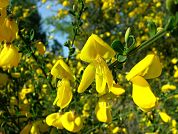The importance of color: floral morphs, visit rates and fitness in the shrub Sarothamnus scoparius
DOI:
https://doi.org/10.25260/EA.16.25.3.0.82Abstract
The study of the intraspecific variability in the flower color may help us to better understand the role of pollinators as selective agents end their effect on the local abundance of floral morphs. We studied the influence of intraspecific variation of flower color on the floral visitation rate and the fitness of Sarothamnus scoparius, a common exotic shrub in Northern Patagonia. Particularly, we determined whether the higher abundance of shrubs with yellow-flowers compared with those with red or orange flowers was consequence of a differential visitation rate of potential pollinators. We 1) measured the visitation rate to yellow flowers and their variants red and orange in natural conditions and in flowers where their color was manipulated; 2) determined whether the visitation rate to red and orange flowers depended on their distance to yellow flowers, and 3) estimated the production of fruit set and seed set in yellow and red flower morphs. We found that: 1) in both, natural and color-modified conditions, yellow flowers received 1-4 times more visits than red or orange flowers; 2) the visitation rate to red and orange flowers decreased abruptly as the distance to yellow flowers increases (7 times in only 100 cm), and 3) both fruit and seed set were ~40% higher in shrubs with yellow flowers compared with those with red flowers. These results suggest that the higher abundance of shrubs with yellow flowers is consequence of a higher visitation rate of potential pollinators, which in turn produce a higher fitness in this floral morph. This work illustrates the importance of pollinators modeling flower characteristics and the influence of floral neighborhood in such process.
References
ARISTA, M; M TALAVERA; R BERJANO & P ORTIZ. 2013. Abiotic factors may explain the geographical distribution of flower colour morphs and the maintenance of color polymorphism inthe scarlet pimpernel. J. Ecol., 101:1613-1622.
BARBOSA, B; J HINES; I KAPLAN; H MARTINSON; A SZCZEPANIEC; ET AL. 2009. Associational resistance and associational susceptibility: having right or wrong neighbors. Annu. Rev. Ecol. Evol. Syst., 40:1-20.
CHITTKA, L & R MENZEL. 1992. The evolutionary adaptation of flower colors and the insect pollinator’s color vision. J. Comp. Physiol., 171:171-181.
CONNER, JK. 2006. Ecological genetics of floral evolution. Pp. 260-277 en: Harder, LD & SCH Barrett (eds.). Ecology and Evolution of Flowers. New York: Oxford Univ. Press.
DYER, AG; HM WHITNEY; SE ARNOLD; BJ GLOVER & L CHITTKA. 2006. Bees associate warmth with floral color. Nature, 442:525-525.
DORMONT, L; R DELLE-VEDOVE; JM BESSIÈRE & B SCHATZ. 2014. Floral scent emitted by white and coloured morphs in orchids. Phytochemistry, 100:51-59.
ECKHART, VM; NS RUSHING; GM HART & JD HANSEN. 2006. Frequency-dependentpollinator foraging in polymorphic Clarkia xantiana ssp. xantiana populations: implications for flower colour evolution and pollinator interactions. Oikos, 112:412-421.
GALEN, C. 1989. Measuring pollinator-mediated selection on morphometric floral traits: bumblebees and the alpine sky pilot, Polemonium viscosum. Evolution, 43:882-890.
LAND, M & L CHITTKA. 2013. Vision. Pp. 708-737 en: Simpson, SJ & AE Douglas (eds.). The Insects: Structure and Function, 5th Edition. Cambridge: Cambridge University Press.
LAVERTY, TM. 1992. Plant interaction for pollinator visits: a test for the magnet species effect. Oecologia, 89:502-508.
LEVIN, DA & ET BRACK. 1995. Natural selection against white petals in Phlox. Evolution, 49:1017-1022.
MELÉNDEZ-ACKERMAN, E & D CAMPBELL. 1998. Adaptive significance of flower color and inter-trait correlations in an Ipomopsis hybrid zone. Evolution, 52:1293-1303
MOELLER, DA. 2004. Facilitative interactions among plants via shared pollinators. Ecology, 85:3289-3301.
MOLINA-MONTENEGRO, M; E BADANO & L CAVIERES. 2008. Positive interactions among plant species for pollinator service: assessing the ‘magnet species’ concept with invasive species. Oikos, 117:1833-1839.
MULLER, H. 1883. The fertilization of flowers. MacMillan and Co. London.
PAPIOREK, S; K ROHDE & K LUNAU. 2013. Bees' subtle colour preferences: how bees respond tosmall changes in pigment concentration. Naturwissenschaften, 100:633-643.
PETER, C & S JOHNSON. 2008. Mimics and magnets; the importance of color and ecological facilitation in floral deception. Ecology, 89:1583-1595.
RENOULT, J; A VALIDO; P JORDANO & HM SCHAEFER. 2014: Adaptations of flower and fruit colours to diversified mutualists. New Phytologist, 201:678-686.
RODRÍGUEZ-RIAÑO, T; A ORTEGA-OLIVENCIA & J DEVESA. 1999. Reproductive biology in two Genisteae (Papilionoideae) endemic of the western Mediterranean region: Cytisus striatus and Retama sphaerocarpa. Can. J. Bot., 77:809-820.
SKORUPSKI, P & L CHITTKA. 2010. Photoreceptor Spectral Sensitivity in the Bumblebee, Bombus impatiens (Hymenoptera: Apidae). PLos One, 5:e12049.
STANTON, ML. 1987. Reproductive biology of petal color variants in wild populations of Raphanus sativus. I. Pollinator response to color morphs. Am. J. Bot., 74:178-187.
STANTON, ML; AA SNOW & SN HANDEL. 1986. Floral evolution: attractiveness to pollinators increases male fitness. Science, 232:1625-7.
STRAUSS, SY & JB WHITTALL. 2006. Non-pollinators agents of selection on floraltraits. Pp. 120-138 en: Harder, LD & SC Barrett (eds.). Ecology and Evolution of Flowers. Oxford University Press, New York, NY, USA.
STREISFELD, MA & JR KOHN. 2007. Environment and pollinator-mediated selection on parapatric floral races of Mimulus aurantiacus. J. Evol. Biol., 20:122-132.
WASER, NM & MV PRICE. 1981. Pollinator choice and stabilizing selection for flower color in Delphinium nelsonii. Evolution, 3:376-390.
WEISS, MR. 1995. Floral color change: a widespread functional convergence. Am. J. Bot., 82:167-185.

Downloads
Published
How to Cite
Issue
Section
License
Copyright (c) 2016 Sabrina S. Gavini, Alejandro Farji-Brener

This work is licensed under a Creative Commons Attribution 3.0 Unported License.
Authors retain their rights as follows: 1) by granting the journal the right to its first publication, and 2) by registering the published article with a Creative Commons Attribution License (CC-BY 4.0), which allows authors and third parties to view and use it as long as they clearly mention its origin (citation or reference, including authorship and first publication in this journal). Authors can make other non-exclusive distribution agreements as long as they clearly indicate their origin and are encouraged to widely share and disseminate the published version of their work.


